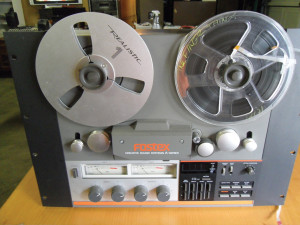BACKGROUND
My best friends and I grew up playing music in the middle of Iowa in a small town where there was a small college. We would play shows at this college as high school students and got to know a lot of the college kids at the time. We often went to the student-run radio station to hang out and play records and be stupid on the air. There was a back room to this radio station where there was a ton of vinyl and other odds and ends. We found this reel to reel in the back with just enough dust on it to claim it as our own. If we wouldn’t have stolen it, someone else would have and certainly nobody was using it at the time.
HOW IT WAS USED
At the time, it was the best sounding thing we had to record music on. This was in the mid-to-late-’90s and we were still pretty young and therefore poor. We were totally into the idea of using tape, but really didn’t understand why. The tape spun in circles like at real studios and we were sure there was extra warmth. I can remember listening to one of our practices trying to focus in on the sound of warmth; I feel like I found it for a second.
LESSONS LEARNED
We held on to it and eventually, when we were recording our band Ticonderoga in the early-2000s, we started experimenting with it again. It was obviously not the best reel-to-reel on the market, but we found that through some nice John Hardy pre-amps it sounded great recording drums in the giant room. We also recorded straight into the computer, but when we A/B’d the computer with the 1/4″ tape, we unanimously chose the Fostex; there was just something special about the natural tape compression.
I have found that it is so much more appealing, aurally, and the experience of recording (and tinkering outside the computer rather than always trying to find a plug-in) is something cool.
MODERN EQUIVALENT
I would say the modern equivalent is GarageBand. In that, the reel-to-reel was for people who were just discovering what fidelity means.
ABOUT THE AUTHOR
Phillip Moore is a vocalist/guitarist in a band called the Bowerbirds. For more, visit www.bowerbirds.org.

